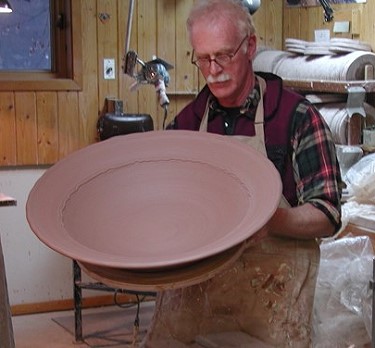 |
| John Glick: |
| A Mentor of the Movement |
| by Charles A. Blim Jr. |
|
|
||
|
|||
|
|||
| Home Articles Links Museum Galleries |
| My large, fat Webster's
Encyclopedic Unabridged Dictionary of the English Language defines mentor
as a loyal adviser of Odysseus entrusted with the care and education of
Telemachus. The secondary definition is simply noted as a wise and trusted
counselor. My personal definition of a mentor is anyone that falls into
my sphere of influence, where I am enlightened or gain knowledge about life
in general. Mentors are my parents, family, teachers, friends and even philosophers
past and present. Their mentoring is not repeated verbatim in my life, but
rather it is a source to view my existence from a different approach. Their
approach has clarified a better understanding of my life on this complex
planet we call earth. To plagiarize any of my mentor's philosophy would
only denigrate their mission. The unspoken language of my mentors is to
take their knowledge and integrate it in my daily existence, where the core
of my being has not been compromised.
When John Glick sent an email request to verify some information on a historical ceramic artist on July 1, 2004, I could barely contain my excitement. His email pushed my mind into overdrive about all the books in my personal collection that I noted his design: Objects USA, American Ceramics, A Century of Ceramics in the United States, The Complete Book of Ceramic Art, A Potter's Handbook, Fifth Edition to just mention a few. His impressive exhibition record was quite lengthy, as well. Although I had all of this information before me, speaking with John Glick provided a deeper sense of who he was. Our first conversation was quite funny, when he teased me that I needed better photographs of his work on Vasefinder rather than the one simple bowl he had made sometime ago. Within just a couple hours, I received a cornucopia of photographs from the legend to add to his Vasefinder museum listing, which I am very grateful. We also spoke about his current apprentice Melissa Vaughn. He is very excited for Melissa, who he clearly believes has her own unique approach to creating ceramics---very different than his. My first impression of John Glick from our conversation was one of a very kind and sharing person, who has a great sense of humor. I interpreted his accolades were his way of quietly stating he took this whole pottery making thing very seriously with no sense of ego. I just thought to myself John Glick has all the traits I look for in a mentor. Here is our exchange about the artist I like to term A Mentor of the Movement. |
|
|
|||||
|
|||||
|
|
|||||
| tree houses, and go-carts that
went on the street that we pushed each other from scrap lumber. Whatever
I was doing--my parents were very supportive. I think this set up the background
to discover a wonderful craft teacher in high school, Mrytle Munro. She
just loved kids and she loved encouraging kids who wanted to try things.
In her class, we learned basic metalsmithing, soldering, enameling, leather
work, pottery, and I tried them all. At that 15-16 year old age, I was most
attracted to metal and pottery work, which carried on from the hobby thing
at home to working with crafts at high school. Myrtle Munro was a Miss---she
was never married. She called all of us her kids. I am one of her kids and
she passed three years ago.
Vasefinder: Where did you study ceramics? John Glick: I was a double major at Wayne State, where I studied metalsmithing and ceramics. I was a student of William Pitney, who was a WW II veteran, who returned to civilian life, and found his interest at Alfred, where he studied with Charles Harder and Daniel Rhodes. His friends were the Secrest brothers. By the second year at Wayne State, I got an inkling that ceramics was going to be my direction. With this inkling, I became the departmental assistant in ceramics, which meant I had the obligations and the enjoyment because I loved it--taking care of the department and ordering materials, cleaning, building and repairing. Whatever was required to keep things going, I did it. By the time I graduated from Wayne State, I was still loyal to the idea of the two disciplines of metalsmithing and ceramics, but the truth was that the handwriting was probably on the wall. I graduated from Wayne State with an undergraduate degree specializing in both areas and received a partial scholarship to the Cranbrook Academy. Within six months, I became the departmental assistant in ceramics under Maija Grotell. And that really confirmed it. I began pulling back from the metalsmithing area, and it was clear by then that the metalsmithing professor advise that it was not a practical idea to try to write a thesis on two subjects. It was a trend I recognized. I just withdrew from any major involvement in the metalsmithing department and became what is called a minor. By the beginning of my second year at the Cranbrook, I was a full declared major in ceramics and finished my last year, where I continued my role as departmental assistant and really knew in my heart it was ceramics. cont. below |
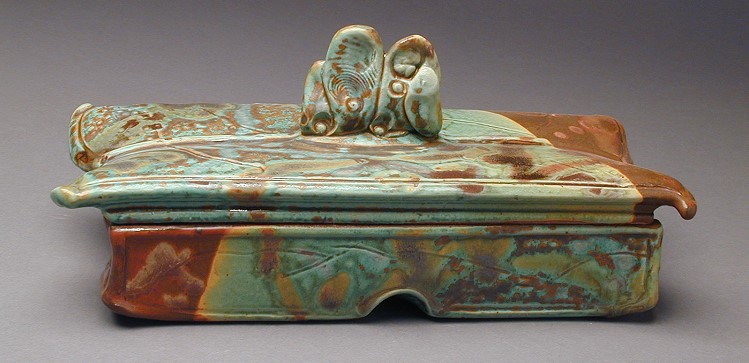 |
| Vasefinder:
Whom do you consider your most important mentors/teachers in ceramics
and how did they influence your style?
John Glick: I think the readers would benefit from reading my internet notes on my teachers/mentors. Please see http://plumtreepottery.com/viewingroom/. But in brief, honestly, I think the biggest influence in terms of stylistic and forms issues did not come from my teachers---although there are some exceptions. The true influence was coming from Japanese pottery and to some degree Chinese and Korean. The emphasis being on Japanese pottery, I began to look at it and seek it out with real attention to its surfaces, as a student at the Cranbrook. I really think the biggest visual impact came from there. Vasefinder: After serving in the United States Army from 1962-1964, you founded the Plum Tree Pottery. What year did you establish the pottery and how did you choose the name? John Glick: I entered the army in 1962. Finished six months training and spent the latter part of 1962 and all of 1963 in West Germany, where I got enormous exposure to their studio pottery. Every third weekend, I use to go and photograph German studios and buy small affordable pots that were inexpensive enough for my small military budget. Those experiences were as informative as some of my classes. I was looking at studio potters in another country and noticing how exciting it was and really kind of putting myself mentally into their situations and saying I could do this and that. They had showrooms, employees and apprentices. This was all exciting. That saved my spirit during those two years I spent time in the military because I did not want to be there because I was drafted per say. It was a wonderful opportunity to get my thoughts together. 1964 was my first year of operation. I was in a rented building in the same community of where I am now in Farmington Hills---just two miles from my current location. In mid-1965, I moved to the current location, where I have been now for almost 40 years. As far as the Plum Tree name, I have a tree growing literally right next to the studio and every spring it sends shoots right under the foundation up into the studio, where there is a crack in the floor and it grows this little branch---it is kind of interesting. |
|
|||||
|
|
|||||
|
they are familiar objects-they are the comfortable, used and enjoyed. And when their time in that particular phase of their life has passed, they have acquired this almost iconic sense. I am not sure if I disagree that they are elevated into a different place then they began. It does happen here and in other countries as well. These pieces are placed in an almost metaphoric or a practical pedestal, and they become something other than what the maker intended. I do not think that way on a daily basis, but I have observed it; I know it exists. And I know people speak to me about it who are my supporters and the people who own my work because I have 40 years of time under my belt with very supportive clients, some of who have followed me for my whole career. In some cases, they have raised children who are supporters of my work, and those children have raised children who are also clients in their twenties. So we now have three generations of that kind of reverence for an artist's work. And I hear them speak about some of the early things they have inherited from their grandparents, which may be my earliest or student work. They do not want to use these vintage objects because they are concerned something will happen to them---there you are. They have separated them from their daily cupboard, so to speak and put them on a metaphoric pedestal in their home. It does happen to me, but it is clearly not my intention. |
|
|
||||
|
|
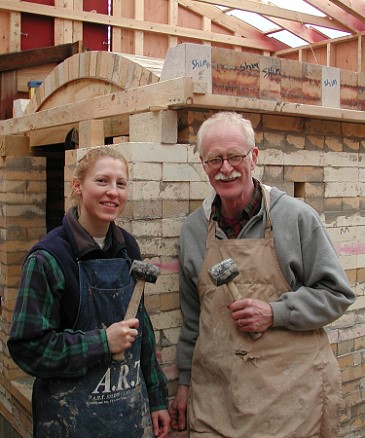 |
||
| that it will make it
almost impossible to participate in the physical level. Out of fairness
to myself, I need a strong person to match my strength and some of my accumulated
frailties with back issues and so on with 40 years of work, so I need a
very strong person in the studio with me. I research with recommenders,
people who have been around the candidates: teachers, employers, and even
friends. And I talk to three people, whoever they are in great depth and
try to really find out what this person is really like personality wise.
And then the candidate must come here for a day and half and we talk non-stop.
My wife meets them. We really ask hard and interesting questions and really
try find out who that person is and what their interests are. If they are
learners and people that are going to blossom in the environment, I believe
there is a pretty good bet we are going to mesh; we are going to have an
excellent mutual exchange, where we can learn from one another.
One of the questions that comes up that I think is the root of any advice is that yes, you can do this. Yes, you can do this, but also absolutely co-sharing and the importance thereof. If this is not going to be fun for you, don't even get started in ceramics. That is fun in the deepest creative sense. If you must turn this into a business of numbers and pounds and inches and that is the main reason you are doing it; I am going to say the chances of you loving it for the rest of your life the way I understand the field are pretty limited and maybe, not so easy to accomplish. I try to infuse a playful period for this year in my assistant's life with me, so they get creative with exploring new ideas and not editing themselves to the point where they have to be so practical not to try a new form-that can be the kiss of death if it is inbred into one's attitude. We spend a good deal of time rehearsing the playful stuff and really doing it and going off on a fancy on a flight of fun about something not doing it the same way. All of these words that apply to being intuitive and letting your intuitive side become a trusted side---that stuff is discussed in a dozen different ways throughout the year. The message is to have fun, but there are a lot of sub-headings under it. cont. below |
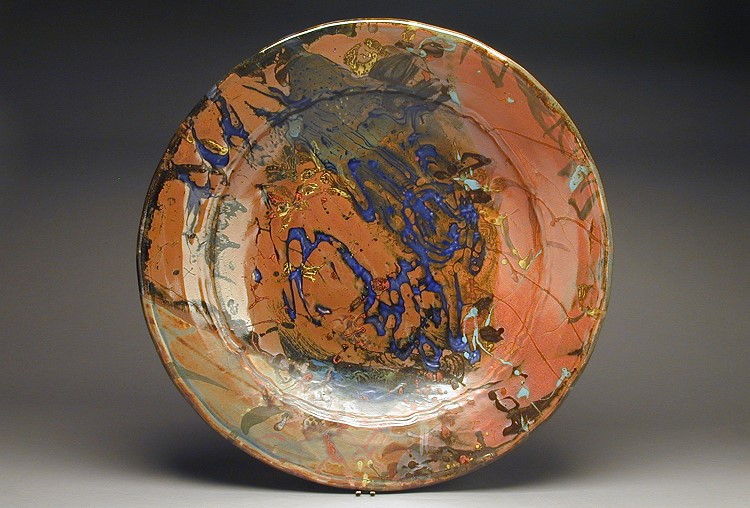 |
|
|
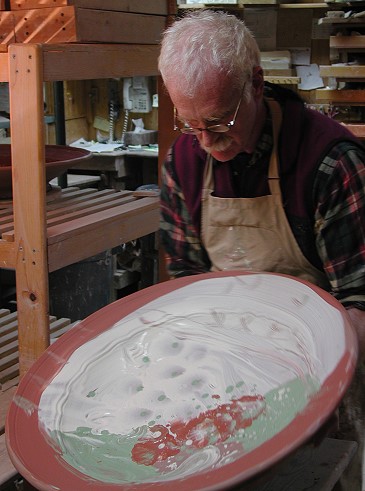 |
| Vasefinder:
Although every object you may create has a separate meaning for you as an
artist, is there a general message behind your art?
John Glick: I guess I would come back to one theme. I have tried to enjoy myself and find creative amusement and engagement in everything I do whether it is a mug or a large wall piece that I consider to be a painting or a large plate or a dinner plate. I tried to feel engaged with each of them as an individual thing and not how fast I can get done with this kind of enterprise. So, I hope what infuses all of them whether they are large and compelling or small and seemingly just rooted in being a good coffee mug. The feeling is that someone cared and took time and felt joy in doing it. If there is a message contained in that regardless of scale that would be the legacy I would have liked to have left in the piece. I wanted to personally thank John Glick for our time together over the last couple months. I feel like I have met a mentor for life. Always the Best, Charlie Blim |
| Please take the time to visit John Glick's Website at http://plumtreepottery.com. |
|
|
||
|
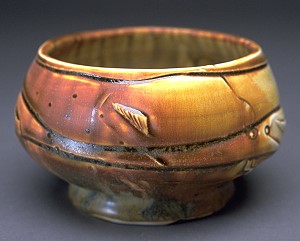 |
|